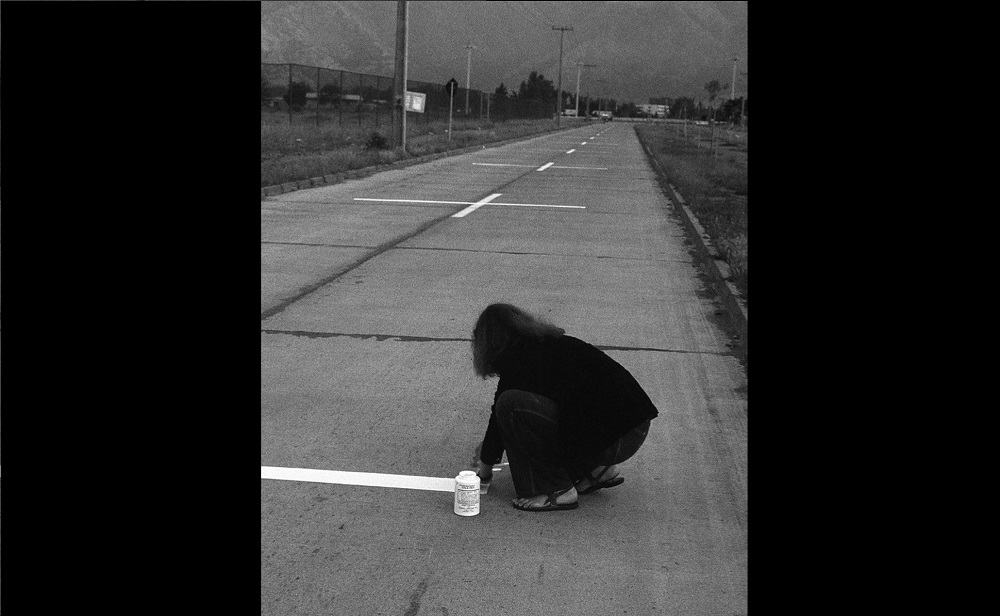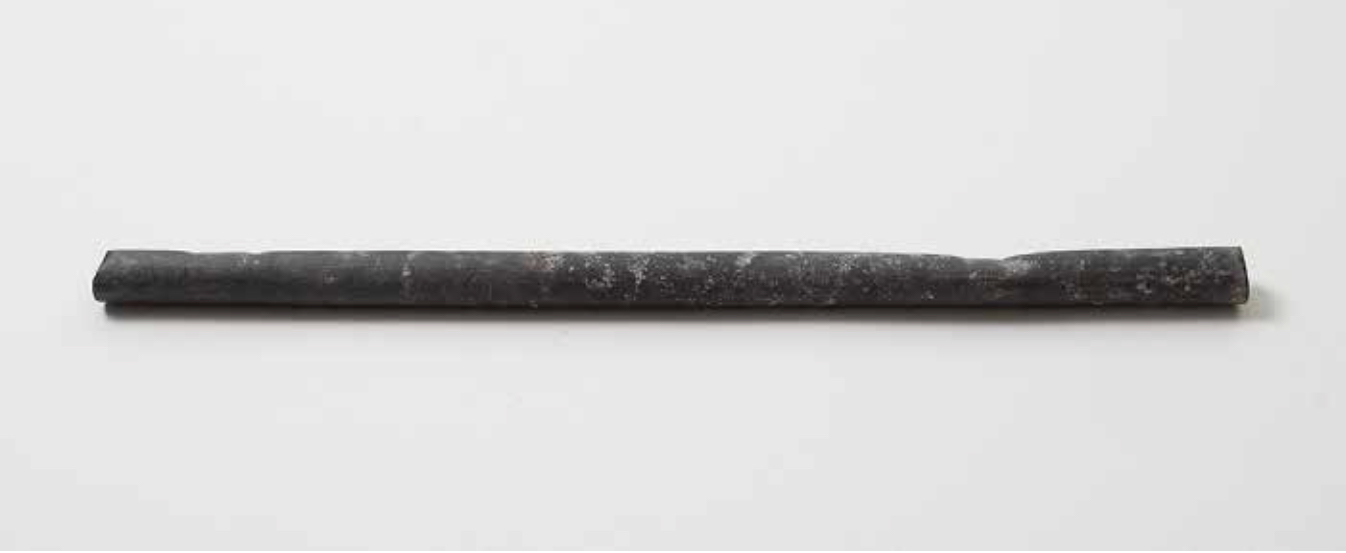Reviews & Articles
Art of the powerless
Eric Otto WEAR
at 11:19am on 25th May 2021


Captions:
1. Lotty Rosenfeld, A Mile of Crosses on the Pavement, 1979–80. (Counter-Public Sphere catalogue photo.)
2. Tamás St. Auby (Szentjóby), New Unit of Measurement, 1965. (Evasions catalogue photo.)
(原文以英文發表,題為〈無權力者的藝術〉。)
In his 1978 essay The Power of the Powerless, Vaclav Havel describes the indivisibility of individual freedom as a continuity from ideology to the experience of daily life. In two recent international exhibitions this is the framework for brief moments experienced during historic conditions of political repression.
‘The Counter-Public Sphere in the Condor Years’ chronicles the responses of dissenting Latin American artists during the 1970s to right-wing military dictatorships and the American-led Operation Condor linking their security services. ‘Evasion Techniques’ focuses on the private actions of non-official artists in totalitarian Hungary at around the same time. The catalogues of both exhibitions and Havel’s essay are online.
The responses of cultural figures to the suppression of democracy in these societies began with uncertainty, then adaptation and only in some cases with immediate resistance. While political changes were sudden, social and cultural life sometimes continued into a twilight period during which hopes continued. An ideology of progress or a promise of stability seduced intellectuals of a leftist or Catholic persuasion respectively, while some of those in positions of cultural authority justified their continued work as being necessary to hold back philistinism (it is curious that nearly all repressive regimes favour not merely conservative art but the aesthetically regressive.) With the consolidation of the regimes and a widening scope of censorship, options narrowed and demands for collaboration with or endorsement of the regimes became more explicit and onerous. Where this was organised or supported by a distant (super)power, local society was further weakened, losing its basic capacity to debate or manage its own affairs. This occurred in Hungary after the crushing of the 1956 rebellion by Warsaw Pact (Russian-aligned) troops, while the interventionist power of the United States was felt throughout Latin America in the 1970s. In both cases, a remote power demanded that locals dance to tunes that were sometimes humiliating and always demonstrated subservience. With time and anxiety, most people in cultural, intellectual and academic positions either became silent, emigrated, or settled into a routine of conforming with the demands of authority because “these things must be done if one is to get along in life.” (Havel)
Direct resistance: the counter-public sphere
However, even as the public sphere was occupied by those acting for the regime, alternatives were sought by the uncooperative. Dissenting artists in Latin America developed an informal counter-public sphere for artworks that could “take place in and / or address public and institutional space (public squares, museums, roads, the sovereign territory)” occupying them “in a surreptitious and unexpected manner” that was “simultaneously hermetic and polysemic while still directly talking back to their authoritarian conditions of production; and that, in their abiding simplicity… attain a maximum of possibilities with a minimum of resources, poetically disrupting the symbolic order with the most economic of means.” Guerrilla events of short duration, these were recognised by peers and subsequently publicised through photographs or personal accounts. As they took place in public spaces they also involved considerable personal risk for the participants, ranging from potential arrest to exile and the confiscation of assets.
Four pieces epitomizing these are, in chronological order, Tapa olho (Eye Patch, 1969) by Antonio Dias in Brazil; 300 metros de cinta negra para enlutar una plaza pública (300 metres of Black Plastic to Swath a Public Square in Mourning, 1972) by Horacio Zabala in Argentina; Inversíon de escena (Scene Inversion, 1979) by the Chilean Collective CADA (Colectivo Acciones de Arte/Art Actions Collective), consisting of poet Raúl Zurita, sociologist Fernando Balcells, writer Diamela Eltit, and artists Lotty Rosenfeld and Juan Castillo; and Una milla de cruces sobre el pavimento (A Mile of Crosses on the Pavement, 1979 – 80) by Lotty Rosenfeld.“
Poetic insubordination
Modern repressive regimes act to monopolise experience and critical reflection, aiming to divest citizens of both their separate identities and their capacity for independent judgement. Not content to leave individuals empty, the regimes also engage artists and intellectuals with the ideologies and rituals that celebrate or justify the new arrangements. In the early days of Communist rule in Eastern Europe, the State exploited the optimism implicit in socialism and presented itself as the vessel of Utopian ideals. When this faded into a distant future it was succeeded by calls for solidarity with a community of nations under Soviet leadership, and defence against enemies within and without. Even when reduced to performances of primal patriotism, obedience to power left some dignity intact. Agreeing to the formula ‘my nation is great’ individuals could say to others (and to themselves) that there was nothing wrong in such a view.
Hungarian artists confronted each stage of manipulative ideology through poetic insubordination. In an environment saturated in symbols and slogans they responded with acts ranging from nonsense to over-enthusiasm. Examples of the latter included apparently spontaneous parades in which they carried posters of Lenin to nowhere in particular, made Communist stars out of ordinary materials and documented these in unlikely locations, or staged cosplay performances in imitation of the state’s heroic sculptures. Through these actions they called out the game as being only a game, illuminating the shallowness of its ideas, and mocking the lack of choice that citizens had in their public obligations.
Other works toyed with doubled meanings. In Hungary, a picture of a police baton was labelled as a ‘New Unit of Measurement’. Or, a city was photographed as recurrent barriers that continually blocked the movement of the individual. History and its fetish images were activated: Sándor Pinczehleyi’s ‘The Cobblestone is the Weapon of the Proletariat,’ presented a pile of cobblestones (or a photo of them) as a reference to popular revolution (and thereafter the Hungarian government banned images of cobblestones!)
In Latin America, in attempting to seize the public space with a counter narrative, common materials were repurposed in temporary installations. A swathe of black plastic was wrapped around a square to suggest public morning without a direct reference to the recent executions of political prisoners (Zabala). Or white strips were laid across the dashed white line of a road, creating ‘a mile of crosses on the pavement’ (Rosenfeld).
Fool, madman and sociopath
In addition to their political or institutional expressions, repressive regimes extend their monopoly on ideology to encompass the common sense views of the people they rule, encouraging the belief that the present arrangements are the ‘best deal on offer’ or the least worst alternative. If possible, they also offer material benefits (at least to some) and consumer choices (or the future promise of such.) In rejecting these offers, uncooperative artists fall the role of the fool, madman, or sociopath. Aside from art this can be an everyday stance that contrasts with the passive and dominated community. As the Evasions catalogue points out, even “tardiness, laziness, impatience, untidiness, imperfection, the accidental, dirtiness – is a form of protest against the order and cleanliness promoted by the regime.” The state condemned such implicit hopelessness as defeatist and unpatriotic.
The art of the fool is one of negation, of disregarding the language and rules of authority, rather like ignoring the traffic signals and signage that structure urban space. In the many examples from Hungary, absurd works took the form of elaborate practical jokes, small in scale and rarely noticed by the public. Performances, works in chalk, marks in snow.
While a source of satisfaction to small groups of artists and their supporters, there was much loneliness and alienation in this fugitive practice. In an economy such as Hungary’s where the state controlled all employment, anti-social practices resulted in precarious lives and led to strict limits on foreign travel. As the participants had to evade surveillance in public space and negotiate problems of personal trust, even a single event might be an all or nothing gamble. This frequently led artists to present themselves as humiliated figures, their helpless bodies suffering the effects of random violence in performances and photographs. The body also was the site of intersectional expressions of dissent, such as that by women artists who presented their bodies as objects and commodities (for instance, Katalin Ladik). This paralleled the mocking of authoritarian patriarchy’s limitations on women’s choices by the Czech filmmaker Věra Chytilová in her surrealist comedy ‘Daisies’ (1966).
Conclusion
Authoritarian regimes’ preferred art is joyful celebrations or dutiful seriousness that rarely relates to anyone’s lived experience. These festoon a public sphere that is muted and dehumanised, where the actors and art of the regime are more or less interchangeable. To oppose this requires a rigorous and comprehensive assessment of ideological circumstances and opportunities. In the experiences documented in these two exhibitions, the crux of resistance was a commitment to a private sphere of relations where the boundaries of art-making and lived experience overlapped. Havel observes that this approach includes “everything from self-education and thinking about the world, through free creative activity and its communication to others, to the most varied free, civic attitudes, including instances of independent social self-organization. In short, it is an area in which living within the truth becomes articulate and materializes in a visible way.” A key dimension of this was also the development of mutual responsibility, involving not only small circles in the country concerned, but the support of artists and curators abroad. When democracy was subsequently restored in Latin America and Hungary, these networks provided resources and histories to re-build the public sphere.
At the time of its making, art made under a repressive regime may seem hopeless and lacking in any capacity to change historical political processes. It can, however, transform individual and social consciousness, working against apathy and providing a practical demonstration of living in truth.
Links:
The Counter-Public Sphere in the Condor Years
Institute for Studies on Latin American Art
New York
15 October 2020 – 15 January 2021
Online catalogue.
Evasion Techniques: Subversive strategy and cocking a snook at authority
in the Hungarian Avant-garde in the 1960s and '70s
Palazzo delle Esposizioni, Rome
4 October 2019 – 6 January 2020
Online catalogue and videos.
